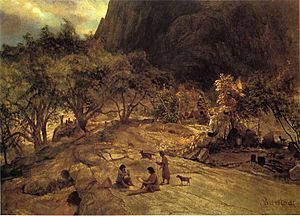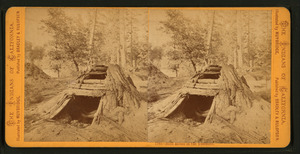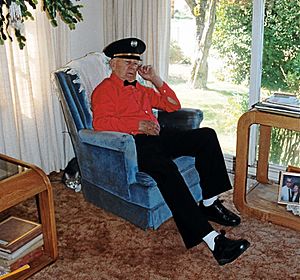Miwok facts for kids
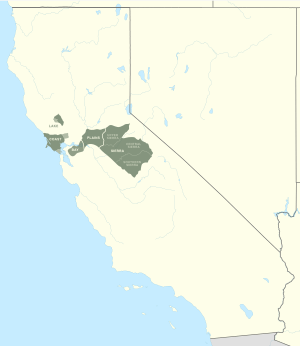
Historical distribution of Miwok peoples in California
|
|
| Total population | |
|---|---|
| 1770: over 11,000 1910: 670 1930: 491 2000: 3,500 |
|
| Regions with significant populations | |
| California: Sierra Nevada Mountains, Central Valley, Marin County, Sonoma County, Lake County, Contra Costa County | |
| Languages | |
| Miwok languages | |
| Religion | |
| Shamanism: Kuksu Miwok mythology |
|
| Related ethnic groups | |
| Subgroups: |
The Miwok (also spelled Miwuk, Mi-Wuk, or Me-Wuk) are Native American groups. They have lived in what is now Northern California and Central California for a very long time. The Miwok people traditionally spoke one of the Miwok languages. These languages belong to the Utian family. The word Miwok itself means people in their languages.
The Miwok People: California's Native Heritage
Miwok Groups Across California
Experts often divide the Miwok into four main groups. These groups lived in different areas and had unique cultures. However, the Miwok people themselves did not use these divisions before Europeans arrived.
- Plains and Sierra Miwok: These Miwok lived on the western slopes of the Sierra Nevada Mountains. They also lived in the Sacramento Valley, San Joaquin Valley, and the Sacramento-San Joaquin Delta.
- Coast Miwok: This group lived in areas that are now Marin County and southern Sonoma County. This includes the Bodega Bay Miwok and Marin Miwok.
- Lake Miwok: They lived around the Clear Lake basin in Lake County.
- Bay Miwok: This group lived in the area that is now Contra Costa County.
Official Miwok Tribes Today
The United States Bureau of Indian Affairs officially recognizes eleven Miwok tribes in California. Being "federally recognized" means these tribes have a special government-to-government relationship with the U.S. government.
- Buena Vista Rancheria of Me-Wuk Indians of California
- California Valley Miwok Tribe, once known as the Sheep Ranch Rancheria of Me-Wuk Indians
- Chicken Ranch Rancheria of Me-Wuk Indians
- Federated Indians of Graton Rancheria, once known as the Federated Coast Miwok
- Ione Band of Miwok Indians of California
- Jackson Band of Miwuk Indians, previously known as Jackson Rancheria of Me-Wuk Indians of California
- Middletown Rancheria of Pomo Indians of California (This tribe includes people of Pomo, Lake Miwok, and Wintun descent.)
- Shingle Springs Band of Miwok Indians, Shingle Springs Rancheria (Verona Tract)
- Tuolumne Band of Me-Wuk Indians of the Tuolumne Rancheria of California
- United Auburn Indian Community of Auburn Rancheria of California
- Wilton Rancheria
Other Miwok Communities
Some Miwok communities are not yet federally recognized. This means they do not have the same official relationship with the U.S. government as the recognized tribes.
- Miwok Tribe of the El Dorado Rancheria
- Nashville-Eldorado Miwok Tribe
- Colfax-Todds Valley Consolidated Tribe of the Colfax Rancheria
- Southern Sierra Miwuk Nation
- Calaveras Band of Mi-Wuk Indians
- Miwok of Buena Vista Rancheria
- River Valley Miwok Indians, once known as Historical Families of Wilton Rancheria
A Look at Miwok History
Many scientists believe that the first people in the Americas came from Asia. They likely crossed a land bridge called Beringia about 20,000 years ago. However, some researchers have different ideas. One idea suggests that the Miwok's ancestors might have come from Siberia by sea about 3,000 years ago. They would have arrived in California much later than the first migrations.
Miwok Daily Life and Traditions
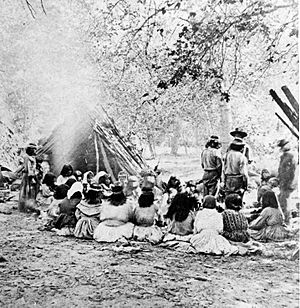
Before Europeans arrived in 1769, the Miwok lived in small groups. These groups did not have one central leader for everyone. They were skilled hunter-gatherers, meaning they found their food from nature. They also had domesticated dogs and grew tobacco.
What Miwok People Ate
The Sierra Miwok people gathered acorns from the California Black Oak trees. They even helped these forests grow by burning small plants on the ground. This reduced the number of Ponderosa Pine trees. They ate almost every other edible plant, including bulbs, seeds, and mushrooms.
They hunted animals using arrows, clubs, or traps. The method depended on the animal. Grasshoppers were a very important food source. Miwok groups near the Stanislaus River also valued mussels. The Coastal Miwok mainly ate food from the inland areas, like San Pablo Bay and lakes. However, they also dove into the Pacific Ocean to find abalone.
Miwok people ate when they were hungry, not at set meal times. They stored food for later, often in special flat-bottomed baskets.
Miwok Beliefs and Stories
The Miwok have many creation stories and traditional tales. These stories are often similar to those of other Native peoples in Northern California. The Miwok had special totem animals. These animals were linked to either land or water groups within their society. These totem animals were seen as special guides or older relatives, not actual human ancestors.
Miwok Languages
The Miwok people speak several related Miwok languages.
Fun and Games: Miwok Sports
Miwok people enjoyed playing games together. One popular game was played on a field about 110 yards long. It was called poscoi a we'a. Both men and women played on each team. The goal was to kick or carry a ball made of elk hide to the other team's goalpost.
The rules were different for men and women. Women could handle the ball in any way they wanted. They could kick it, pick it up, and run with it. Men, however, could only kick the ball. Interestingly, a man was allowed to pick up a woman who was holding the ball and carry her to the goal.
Miwok Population Over Time
In 1770, historians estimated there were about 11,000 Miwok people. This included about 500 Lake Miwok, 1,500 Coast Miwok, and 9,000 Plains and Sierra Miwok. Some experts believe the total population in 1769 might have been at least 25,000 people.
By 1910, the U.S. Census reported 671 Miwok people. In 1930, this number was 491. However, by the year 2000, the total number of Miwok people had grown to about 3,500.
See also
 In Spanish: Miwok para niños
In Spanish: Miwok para niños


